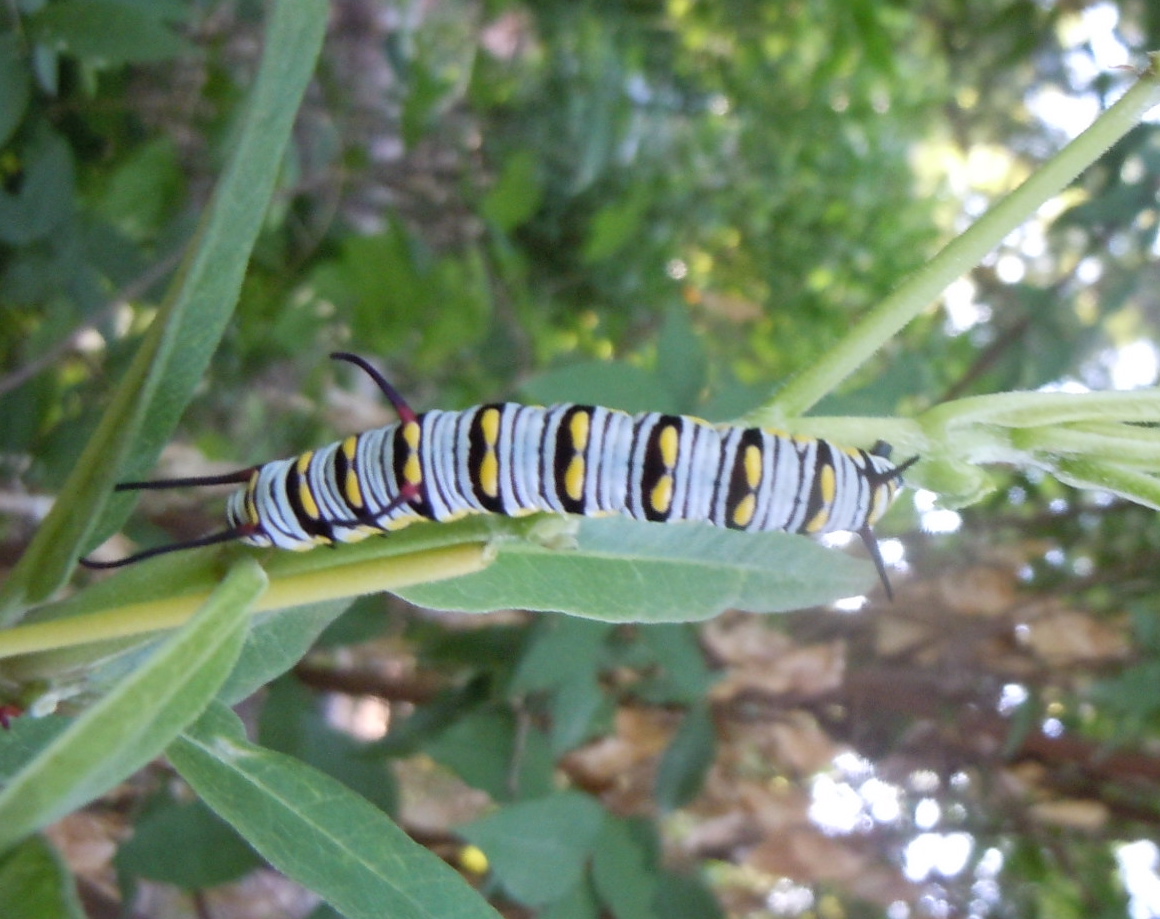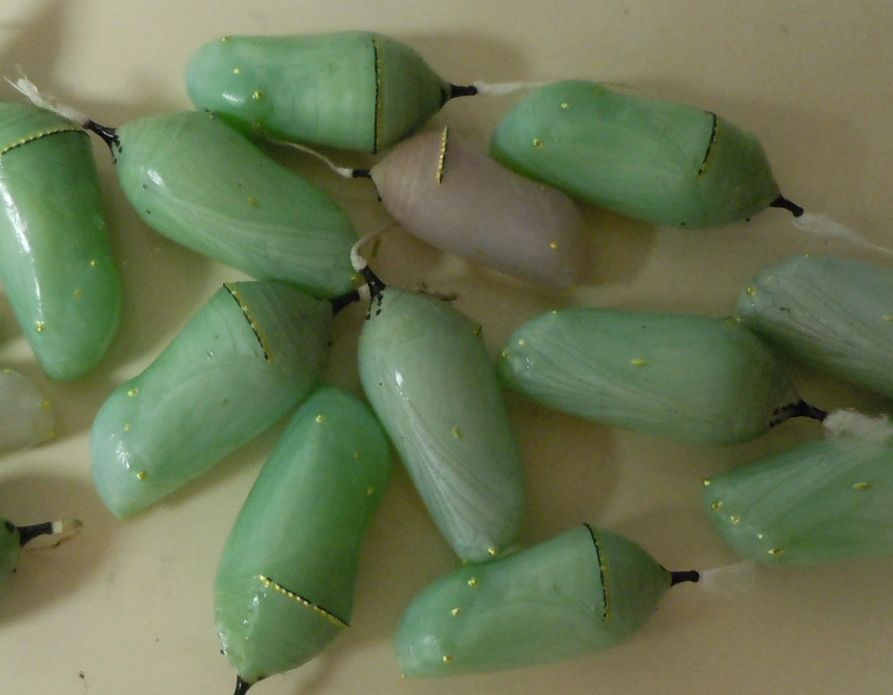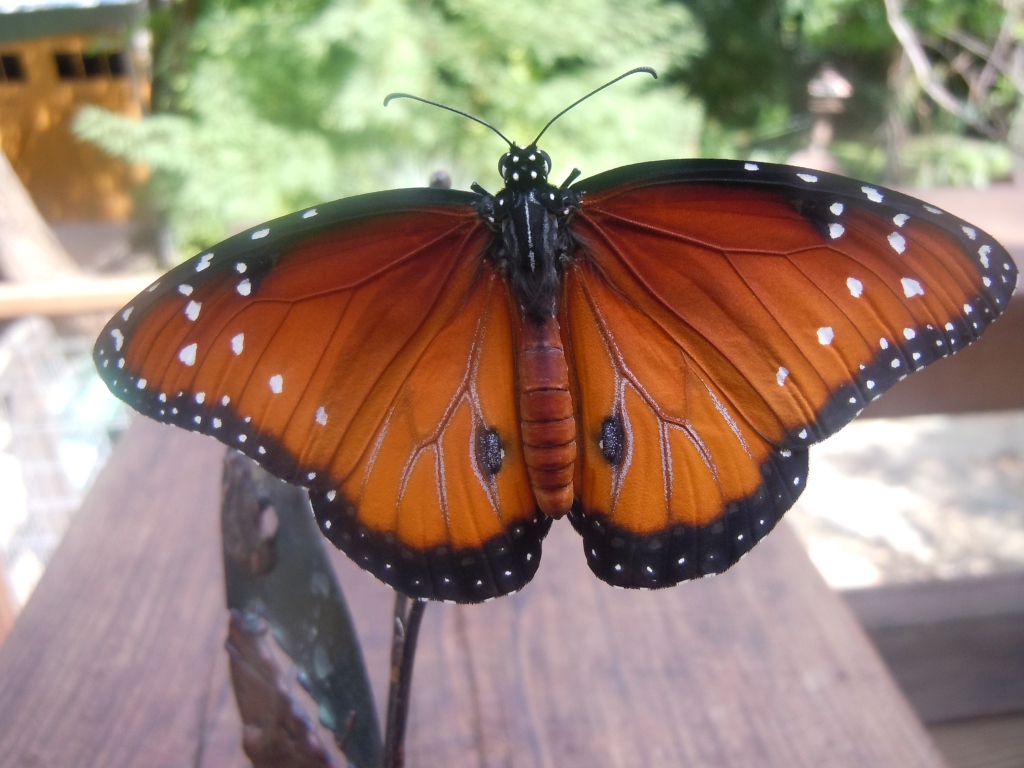Monarch butterflies get all the press as our most beloved species while the Queen, a close cousin, goes largely ignored. Life’s not fair, even for butterfly beauties.
Upon close inspection, you’ll find that Queens share the charms of their closely related Monarch sisters, including large size, bright-striped caterpillars and chrysalises that resemble a gold-dotted jade crystal.
If you have flowers blooming now, you’re likely seeing Queens, Danaus gillippus. Like Monarchs, Queens host only on milkweed, but they nectar indiscriminately. During this historic Texas drought, they’re clinging to river bottoms, seeking the goldenrod and swamp milkweed that blooms in late summer. In our gardens, they gravitate to lantanas, pentas, milkweed and purple mistflower.
 Queen butterflies, wings folded, on Purple Mistflower
Queen butterflies, wings folded, on Purple Mistflower
Queens generally precede the Fall Monarch parade. While they don’t migrate like Monarchs, they are seasonal, showing up in the Spring and Fall.
Telling the difference between the two can challenge butterfly observers. On first glance, Queens and Monarchs seem identical, but look closely and you’ll see that Queens are solidly burnt orange, almost brown, with wings folded. Monarchs have much more variation in their coloring. With wings open, the difference is more striking. Queens
 Queen Butterfly, wings open. Oh, and it’s a male.
Queen Butterfly, wings open. Oh, and it’s a male.
display none of the “stained glass” veins of Monarchs (see the banner photo at the top of this web page). Queens’ open wings boast a solid orange-brown, with only white specks on the outer edges and a black outline.
In the caterpillar stage, Queens flaunt similar Monarch-like yellow and black stripes, but they also sport three sets of filaments, the amusing antennae-like protuberances that seem to feel the world around them in expressive contortions. Monarchs display only two. Queens also wear a red accent where those filaments connect to the caterpillar, presumably a warning sign to predators: Stop, don’t eat me!
 Queen Caterpillar on milkweed
Queen Caterpillar on milkweed
As a chrysalis, Monarchs and Queens could be twins, except that Queens are slightly smaller. Both attach themselves vertically from a a horizontal surface with a silk button after forming a “J” shape, then spin a shiny green chrysalis flecked with gold dots. While some butterfly species opt for disguises verging on the disgusting in the chrysalis stage–as bird droppings (Red-spotted Purples) and dried crinkled leaves (Gulf Fritillaries)–Queens and Monarchs win the chrysalis beauty pageant. Their fantastic jade coloring and intriguing gold flecks provoke some folks to wear them as jewelry. (Not something I recommend.)
 Queen Chrysalises are usually smaller than Monarch Chrysalises
Queen Chrysalises are usually smaller than Monarch Chrysalises
For more tips on how to tell the difference between Queens and Monarchs, see these blogposts from the Texas Butterfly Ranch archives:
Queen Butterfly or Monarch Butterfly? Sometimes it’s Hard to Tell the Difference
How to tell the Difference between Future Monarch Butterflies and Future Queen Butterflies, Part II

 Queen Butterfly, wings open. Oh, and it’s a male.
Queen Butterfly, wings open. Oh, and it’s a male.
I’m pretty sure we used to see both of these guys in rural Michigan. But so far I’ve only seen Monarchs in urban Massachusetts. I always thought Queens were just some Monarch variation (which, linguistically, I suppose they are). Now I know better.
Ken
PS I’m watching the coverage of the fires in Austin VERY attentively. Hope everybody’s okay.
Your photography is outstanding, and so is the narrative. WIsh you’d do more on the specifics of the queen butterfly life cycle 🙂
Thanks for the kind words. It was a shoddy season for Queens–and all butterflies–last year. Hopefully 2012 will be better. What, in particular, are you curious about?
Monika
I guess I have several questions. (And Thank you)
*Does temperature attribute to the length of time it takes a cat to go from 1st instar to actually being a butterfly?
*What is the normal (or accepted) length of time this takes?
*How would one captively try to protect and raise them?
*Are the asclepias bugs I find on the a. curravassica harmful to the cats?
I have several that have begun visiting me because I started growing plants they love for both nectar and cats, and I’d like to help them along. I find them as beautiful as the monarchs. 🙂
Yes, temperature effects the amount of time it takes for butterflies to develop. In late summer it seems to happen much more quickly–10 days or less from egg hatching to chrysalis for Monarchs. Here in the winter it has been taking three weeks or so. Usually it takes about 3 – 4 days as an egg, 10 – 14 days as a caterpillar, and seemingly 7 – 10 days as a chrysalis.
The asclepias bugs. Not sure what you’re referring to here. For complete info on raising Monarchs, check out the Monarch Watch page athttp://monarchwatch.org/rear/index.htm.
Good luck!
Monika
[…] learn more Queens, Monarchs and their migration, please visit: http://www.butterfliesandmoths.org/ http://www.texasbutterflyranch.com/2011/09/05/queen-and-monarch-butterflies-share-beauty-charm-and-g…http://www.learner.org/jnorth/tm/monarch/DiscoveryTale.html […]
I could swear the queens are a little bigger than the monarchs. So far this year I’ve had more queen butterflies. Do you battle those stupid yellow aphid things on the milkweed and how do you deal with it? I swear they are eating the eggs and larva of the monarchs.
Yes, if you have milkweed, you will have aphids. I just squish them with my fingers. I don’t believe aphids eat eggs, but many of the predators like ants, ladybugs, wasps, who are drawn to the plants they infest do, so best to get rid of them. They also literally suck the life out of the plant and degrade them. Good luck! –MOnika
Spray them off with water bottle and I sprinkle ground red pepper around base of plant to eliminate ants, also I use tongue depressors and add drops of eucalyptus to keep geckos away.
I currently have a large monarch caterpillar eating the milkweed with aphids on the plant…so far so good! He is looking large and healthy so far!!
I live in the Central Valley of California. Squished thousands of Aphid in the last month on my multiple varieties of Milkweed. I never had a Monarch egg in my garden. What am I doing wrong?
Glenn, it’s impossible to say from here. Do you have Monarchs flying around?
I had one of these laying eggs on my milkweed, but didn’t know what it was. I tracked the caterpillars by keeping them on a separate plant. So far, three of them are surviving and hope to see them go through the evolution. This website helped me determine what this actually was. Thank you.
What makes the little good dots on the cocoon?
Yellow “aphids,” I found out are the “infant” stage of the orange and black milkweed bugs. They multiply rapidly and cover the Asclepius tuberosa “butterfly milkweed” plants, spilling over onto everything else located nearby.
I have a queen chrysalis only two days in. I’m concerned as it now is the color of the chrysalis in the center of the above photo. I have isolated it. Is there reason for concern, or can this happen and still be healthy?